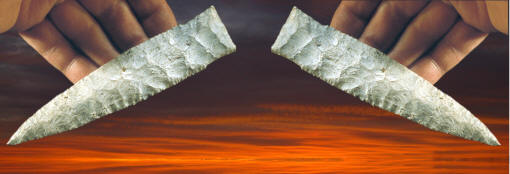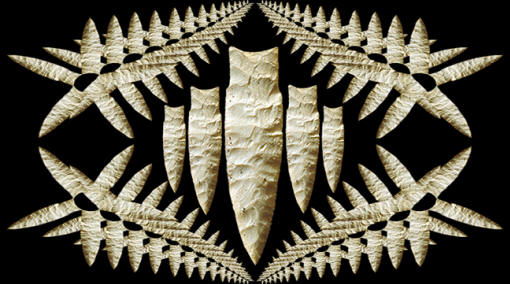|
"On a small
rise between 1st and 2nd bottom land, on the inside bend of the river (Skunk
River), I
came upon a spear of superb workmanship."---1971,
Warren Holland, "Dalton-Type Cache Found," Central States
Archaeological Journal, Vol. 18, No. 1, p. 22-24.
"The Holland point has been named
tentatively (in 1971)
by Gregory Perino for a cache of 14 points found in 1966 by Warren
Holland----while surface hunting a plowed field terrace along the skunk
River, Henry County, Iowa."---1971,
Gregory Perino, "Guide To The Identification Of Certain American
Indian Projectile Points" p. 56.
"The Holland
point is one variety of a group of large unnamed early Archaic points
commonly found in the Midwest."---1971,
Gregory Perino, "Guide To The Identification Of Certain American
Indian Projectile Points" p. 56.
"."---1987,
Noel D. Justice, "Raddatz Side Notched," Stone Age Spear
And Arrow Points Of The Midcontinental And Eastern United States, p.
67.
"The Holland point seems to have a relationship with a
large contemporary Dalton form, the Sloan point."---1985,
Gregory Perino, "Selected Preforms, Points And Knives Of The North
American Indians," Vol. I, p. 187.
"All members of the Dalton family show very
high quality workmanship with a combination of percussion and pressure
or are completely covered with pressure scars, so skillfully executed
that in many cases the points appear to be parallel or obliquely flaked."---1987,
D. C. Waldorf, "Story In Stone, Flint Types Of The Central And
Southern U.S., p. 60.

THE HOLLAND CACHE
EARLY ARCHAIC PERIOD
IOWA
Isolated discoveries of caches of projectile points and knives have been
found all over the United States. The reason for their placement in the
ground at any one particular location is often times not clear and the
Holland cache is no exception. No other caches have been reported from
the Holland cache site. In fact, only four or five other Dalton
artifacts are reported from the site in the form of two adzes, two
points and a possible drill.
|
|
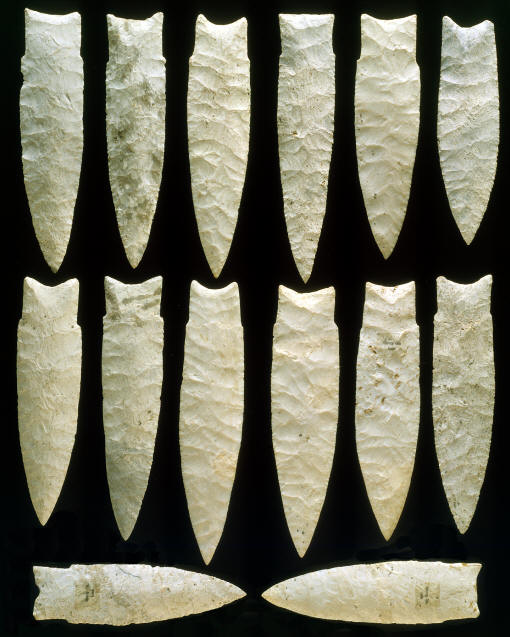
CLICK ON PICTURE FOR LARGER IMAGE
THE HOLLAND CACHE
HENRY COUNTY, IOWA
EARLY ARCHAIC
These 14 points were discovered in a plowed field in Henry County,
Iowa in 1966 by Warren Holland. They have been designated the type
points for Holland points. The cache is interesting for three
different point styles that are represented within the cache. Twelve
of these points have excurvate blade edges, small shoulders and
concave bases and one other point has a straight base instead of a
concave base. One of the most interesting points in the cache is the
one that does not have any shoulders at all (top
row right side). It represents
one of the classic forms of a Dalton point, which in this case
illustrates a close connection to stemmed and shouldered points. All of these points are made of white Burlington
formation chert of varying degrees of quality. They range in size
from 4 1/4 inches (10.8 cm) to 5 5/8 inches (14.3 cm) long and from
1 1/8 inches (2.9 cm) to 1 5/16 inches (3.4 cm) wide. The thickness
range is from about 7 mm to 8 mm.
Perino describes the Holland cache points, "Of the 14 points
found in the cache, thirteen have shoulders 1 to 2 mm wider than the
stems. One has no shoulders being lanceolate in form (top
row right side), contracting
slightly from the widest point near the center of the blade to the
base. It may have had shoulders that were removed in resharpening
the point. Ten points are typical and have essentially
straight-sided stems. Three points have slightly contracting stems
and one point has an expanded stem, only one has a straight basal
edge (4th from left). Ten have slightly concave basal edges, 2 to 3 mm deep, and
three have moderately concave basal edges 6 mm deep." (Perino 1971) |
|
|
The Holland cache was named after Warren Holland who
discovered the cache on May 2, 1966. The points in the cache are
recognized as the type points from which Holland points have received
their type name. Greg Perino named them in 1971. |
|
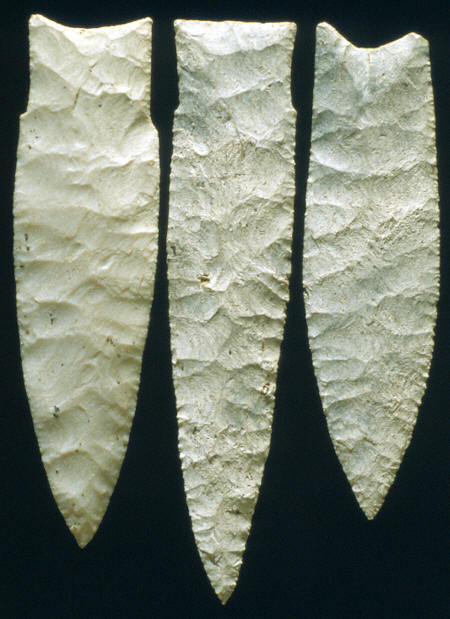
HOLLAND CACHE POINTS
HOLLAND CACHE
HENRY COUNTY,
IOWA
EARLY ARCHAIC
These
Holland cache points illustrate the three different style variations
within the cache. The point on the left is a good example of a
typical Holland point. It has excurvate blade edges, slight
shoulders, a straight sided stem and a concave base. The point in
the middle is a slight variation. It has a stem that expands
towards the base and the base is straight instead of concave. The
point on the right is a Dalton point. It
has recurved blade edges, a concave base and unlike all the other
points in the Holland cache this point has no shoulders. All three
points are made of Burlington chert and the longest point in the
center measures 5 5/16 inches (13.5 cm) long. |
|
|
Warren Holland describes his discovery of the cache as, "I
came upon a spear of superb workmanship. While admiring my find, I saw
another, then another and within a few minutes I had recovered five
spears and two halves from the plowed earth." He then went on to find
six more that day, in the same location, that were stacked one upon the
other in the bottom
of a "dead" furrow. (A "dead" furrow is one in which the dirt is thrown
both ways and is therefore deeper than an ordinary plow furrow) He found another
point later that year and the
last one the following Spring for a total of 14 points. |
|
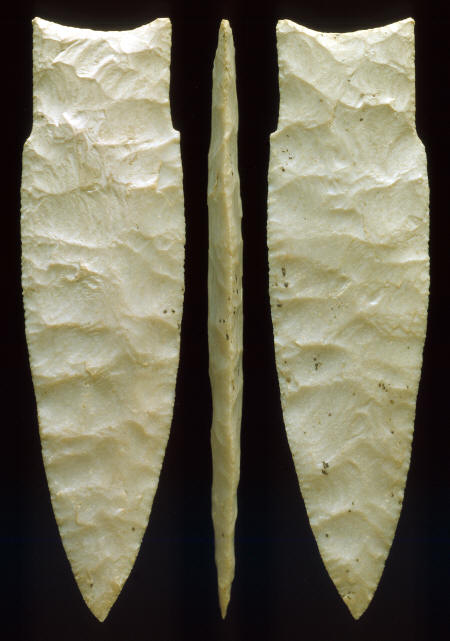
CLICK ON PICTURE FOR LARGER IMAGE
HOLLAND POINT
HOLLAND CACHE
HENRY COUNTY,
IOWA
EARLY ARCHAIC
This is a good example of
what might be called a "classic" Holland point. It has excurvate
blade edges, slight shoulders, a straight sided stem and a concave
base. The over all flaking is fairly random. The edges have very
fine pressure flaking with small serrations. This point is made of white Burlington chert and it measures 4
13/15 inches (12.2 cm) long. |
|
|
Mr. Holland described the site as being, "on a field which
had yielded very little (artifacts) and showed few signs of occupation."
He also described the site location as being, "on a small rise between
1st and 2nd bottom land, on the inside bend of the river (Skunk River)." |
|
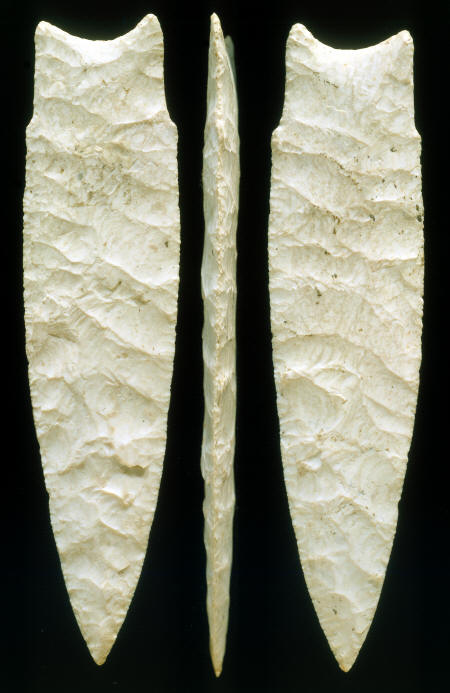
CLICK ON PICTURE FOR LARGER IMAGE
HOLLAND POINT
HOLLAND CACHE
HENRY COUNTY,
IOWA
EARLY ARCHAIC
This is the longest Holland point in
the cache. It has better than average flaking. The flakes are
generally in a parallel oblique pattern. The blade edges are excurvate, it
has slight shoulders, straight stem edges and a concave base. This
point is made of white Burlington chert and it measures 5 5/8 inches
(14.3 cm) long |
|
|
The Holland cache is important because it shows a clear
connection between some Early Archaic shouldered points to Dalton
points. The fact that one Dalton point was found in the cache suggests
that the stemmed and shouldered points in the Holland cache are another
form of Dalton point. There are very many different types and styles of
Dalton points. |
|
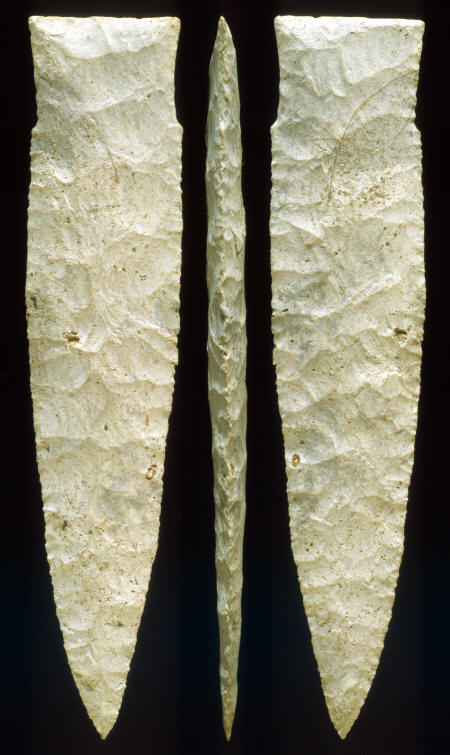
CLICK ON PICTURE FOR LARGER IMAGE
HOLLAND POINT
HOLLAND CACHE
HENRY COUNTY,
IOWA
EARLY ARCHAIC
This picture shows three views of the only Holland point in the
cache that has a straight base. All the other Holland points in the
Holland cache have concave bases. This point also has an
expanding stem and an oblique flaking pattern. It's made of
Burlington chert and measures
5 5/16 inches (13.5 cm) long. |
|
|
Perino describes Holland points as maybe related to a large contemporary
Dalton form called a Sloan point. He describes Holland points as being
thin medium to large size lanceolate forms with slight shoulders. He
describes the stem edges as being either straight, slightly expanding or
contracting with edges that are slightly ground. The basal edge may also
be either straight, concave or recurved and the basal corners are
sometimes "eared." In-other-words there are also many different styles
and forms of Holland points. |
|
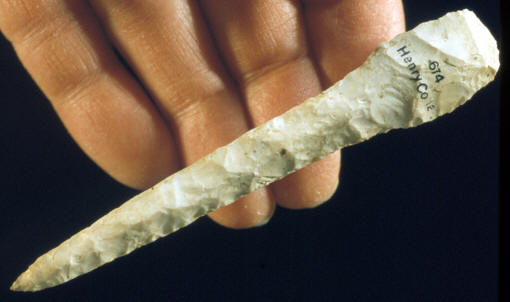
DRILL OR PERFORATOR
HOLLAND CACHE
HENRY COUNTY,
IOWA
EARLY ARCHAIC
This drill or perforator is also
reported to have been found by Warren Holland with the Holland
cache, but it was never reported or illustrated in any of the
published articles about the cache. Other caches of Dalton culture
artifacts, such as those found on the Sloan site, also contain
points along with various types of tools in the same caches. So it's
not surprising that a tool such as this drill would have been
discovered in the Holland cache. This drill is made of Burlington
chert and it measures 4 7/16 inches (11.2 cm) long. |
|
|
Holland points are found in several Midwestern states.
The reported distribution area for Holland points is in Wisconsin,
Minnesota, Iowa, Missouri, Illinois, Arkansas and eastern Oklahoma. Some
of these locations are also where the core concentrations of Dalton
points are found, but the distribution area for Dalton points is very
much larger than for Holland points. |
|
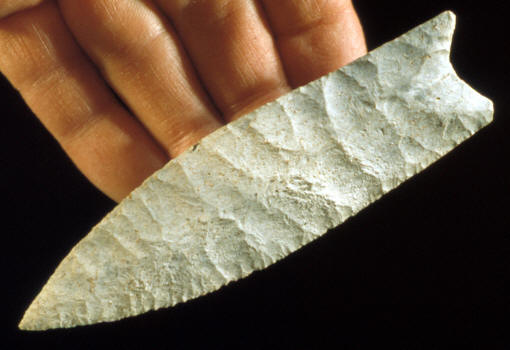
DALTON POINT
HOLLAND CACHE
HENRY COUNTY,
IOWA
EARLY ARCHAIC
This is the only point in the Holland
cache that does not have shoulders and it's easily identified as a
Dalton point. This suggests that the stemmed and shouldered points
in the Holland cache represent other forms of Dalton points. This point is made of Burlington chert and it
measures 4 9/16 inches (11.6 cm) long. |
|
|
Caches have proven to be unique opportunities for archaeologists to gain
new insight into the social structure of ancient cultures. The earliest
examples in North America are Clovis caches, such as the
Drake cache, or the
Mckinnis cache. Some of
the more recent caches belong to the Mississippian period and a couple
of these are the Mound 72
caches, and the St. Clair County, Illinois
celt cache. Some caches
contain exotic materials that were traded into the area from distant
locations and show a connection to different people. They can also show
an unexpected form variation of an artifact type that was produced by a
single individual craftsman. The Holland cache is a good example of this
where shouldered points and a Dalton point were found together. The main
purpose of caches seems to have been as use as mortuary offerings to the
dead. |
|
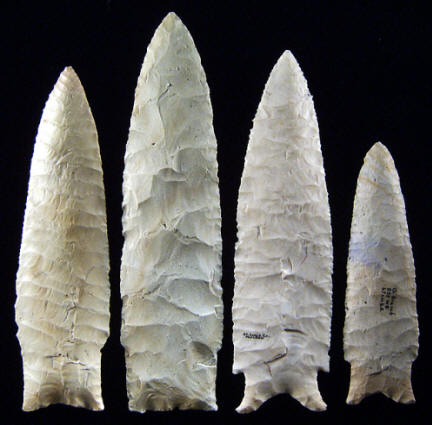
HOLLAND POINTS (Casts)
MISSOURI & ILLINOIS
EARLY ARCHAIC
The four points in this picture are
casts molded from Holland points that were found on sites in
Illinois and Missouri. They show the wide variation of form this
point type is known for. The quality of flaking ranges from random
(2nd point left), to very well done parallel oblique flaking (1st
point left). The stem edges are either straight or expanding and the
basal edges are either straight or concave. The point, second from
the left, also has a small "ear" projection on the basal corner on
the right side.
The third point from the left is a highly developed form of
Holland point. The shoulders on this point are slightly corner
notched. There is some reason to believe that Holland points
represent the beginning forms of Hardin Barbed points. Perino writes
that, "They (Holland points)
may represent a combination of the Dalton-Hardin point traditions in
the Midwest." Holland
points were being produced towards the end of the Dalton period at a
time when Hardin Barbed points also began to be produced. Hardin Barbed
points and Dalton points were found together in the same upper
levels on the Olive Branch
site in southern Illinois. The point at far right was excavated
on the Olive Branch site. |
|
|
No one will ever know for sure why someone more than 9,000 years ago
buried the Holland cache on what is now a farm field in southeastern Iowa. It was
lucky that Warren Holland was able to discover them just at the moment
they reappeared on the surface. The finely crafted points in the Holland
cache must have been important to the people who made them. Perhaps they
were once placed as offerings to someone who had died but now only the
stone remains. What we do know for sure is that the Holland cache has added a little
more knowledge about a group of people who once lived long ago during
the Early Archaic Dalton period. |
|
"REFERENCES"
1971, Holland, Warren, "Dalton-Type
Cache Found," Central State Archaeological Journal, Vol. 18
Number 1, pp. 22-24.
1971, Perino, Gregory, "Guide To The Identification Of Certain
American Indian Projectile Points," pp. 56-57.
1985, Perino, Gregory, "Selected Preforms, Points and Knives Of The
North American Indians," p. 187.
Personal Communications with Jim Marlin.
|
|
RECENT
LISTINGS HOME
ORDERING |
